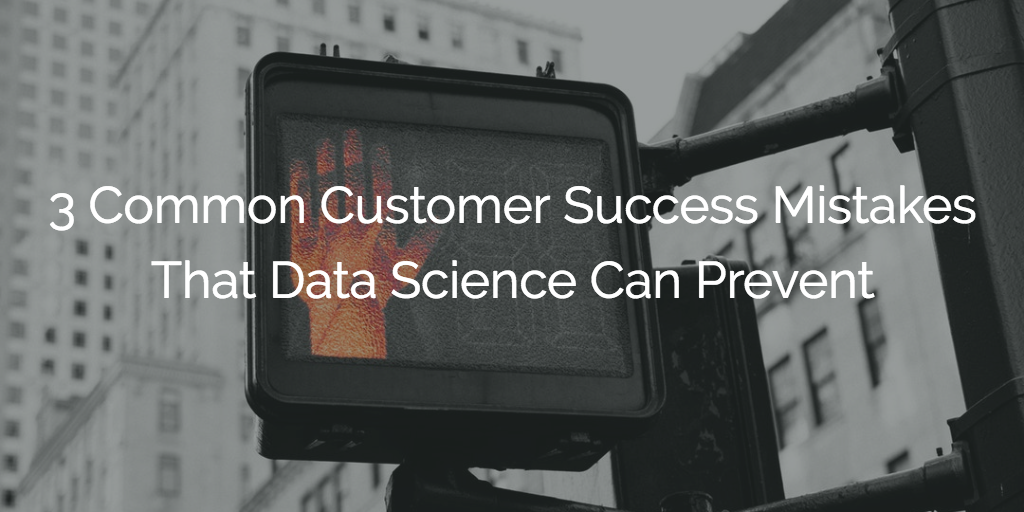Companies that want a true competitive advantage in their marketplace must make their customer experiences a priority—but to do this correctly, you need data science.
The customer today has more power than ever before. They have seemingly unlimited options and information when it comes to making buying decisions. Thus it is vital that you hold on to each and every customer that chooses to invest in you. Customer Success has emerged from this need to retain customers. I’ve delivered technical solutions for over 150 companies and have seen the effects that messy data has on their strategies. You may think your Customer Success is going well, but I’d like to challenge that. Your Customer Success is doomed without data science. Below are three ways your Customer Success will suffer if you don’t add data science into the mix.
What is data science?
Data Jobs defines data science as, “a multidisciplinary blend of data inference, algorithm development, and technology in order to solve analytically complex problems.” Companies collect insane amounts of data but a large percentage of it often goes unused. Data science taps into these troves of information to extract business value in a methodical way.
Mistake #1: Without Data You’re Taking Shots in the Dark
One of the core tenets of Customer Success is defining rules that capture risk and opportunity. For example, if a customer creates a support ticket and that ticket is open for more than 30 days then they are flagged “at-risk” or “unhealthy”—presumably because the issue that was raised in the support ticket has not been resolved. There’s a problem with this practice though. While we might think we know what’s driving customer behavior, we don’t know if it’s statistically accurate.
Let me share a personal example. A client of mine had a ticket creation method that seemed to be good overall. They factored in ticket duration, severity, and if a case had been open for 30 days or more. But they had developed these thresholds, as most companies do, with a combination of previous experience and anecdotal guesses—not from data. After further analysis, we discovered that the biggest indicator was the lack of support tickets. Customers that weren’t reaching out for help were the ones most likely to churn. So, in this case, the assumptions they made were flawed. I have seen many cases like this in my career. Without data science, assumptions we make in business often do not match the outcomes that occur.
Mistake #2: Without Data You’re Not Prioritizing the Right Things
I find that this instance usually occurs in customers that have conducted some basic internal correlational analysis. Unless you have an analytical Data Science team with experience working on Customer Success use cases, your company is at a higher risk of missing the mark. If you fail to look at the problem from a data science perspective, things can go wrong. Your team can either become overwhelmed, ineffective or both.
It’s important to understand that even within one homogeneous set of customers there might be multiple layers of insight. Black box and linear regression models that work for things like lead scoring and ranking marketing outreaches fail to perform in Customer Success use cases. This is because every post-sales insight is multivariant, meaning it has multiple layers and factors. For example, say you have a customer that only has a 25% adoption rate. This is generally a poor score but it’s highly dependant on the circumstances surrounding it. Is the customer a large company or a small one? How does the behavior vary across the user roles? What about the customer’s industry? Knowing the answers to these questions will help you to prioritize the way you address adoption risks in the future.
Mistake #3: Without Data You’re Missing the Big Picture
Starting any project without an outcome in mind is doomed to overreach or miss the mark entirely. Your Customer Success strategies need to lead each customer to their desired outcome. If this paradigm isn’t in place, you’ll find yourself scrambling to gather any information you can to explain how a customer became at-risk or missed their desired outcomes when they purchased your product or service.
This comes up often in the “Code Red” meetings that happen when customers become labeled as a risk. There’s a scramble to figure out what has happened and what it means for the account. Companies who don’t use data science are at a severe disadvantage here. For them, it’ll be much harder to determine the context-based factors that have impacted the customer’s at-risk status. The discussions that follow are harder and require more effort to get down to the bottom of the problem. Data science is an invaluable resource when it comes to aligning the different contextual aspects of the customer experience with a customer’s outcome.
In conclusion…
The Customer Success revolution has transformed how businesses approach their customer experiences but that’s just the beginning. Where companies can continue to improve their customer outcomes is by adding data science to their core CS strategy. Without data science, your company is moving forward without a goal in mind, feeling their way along in the dark as they go. Data science is the flashlight, providing the light they need to move with purpose and confidence in the right direction. Check out this article to learn more about making a case for data science in your company.
As always, I’m happy to talk to fellow data enthusiasts! And, if you’re a CSM, admin, or executive in Customer Success, I’d love to talk to you about how to incorporate data science into your strategy. If you have any questions or would like to learn more about the data science services we provide at Gainsight, I encourage you to reach out at scummings@gainsight.com.

